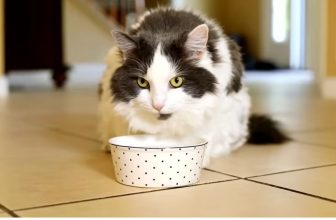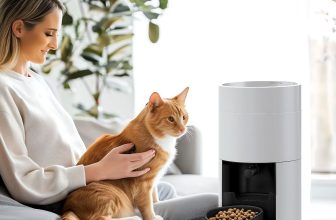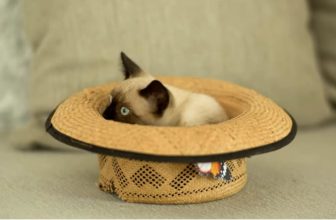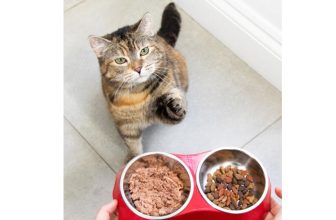What Does Cats Eat? Best Complete Guide to Your Cat’s Diet-foodts.com

What Does Cats Eat: As a responsible pet owner, understanding what your cat eats is essential for maintaining their health and happiness. A cat’s diet can influence their energy levels, coat condition, and even behavior. So, what does a cat eat? In this guide, we’ll explore the best foods for your feline friend, from their favorite treats to key nutrients and dietary tips to ensure they stay healthy for years to come.
What Is a Cat’s Favorite
Cats, like us, have food preferences, but their needs are more specialized due to their carnivorous nature. Cats are obligate carnivores, requiring a diet rich in animal proteins. This is because their bodies are specifically designed to digest meat, and they cannot process plant-based foods like humans or omnivores can.
Meat-Based Foods:
A cat’s favorite food is typically rich in protein, with chicken, turkey, beef, and fish being common choices. These meat-based foods mimic the natural diet of wild cats and provide the essential amino acids necessary for a cat’s health. Cats need protein for growth, muscle maintenance, and energy, so choosing high-quality animal proteins is critical.
Wet vs. Dry Food:
While wet food tends to be more aromatic and moist, which many cats find irresistible, some cats prefer the crunch of dry kibble. Wet food also helps cats stay hydrated, which is important for their urinary tract health, while dry food can aid in cleaning their teeth. The key is to offer a variety of both to ensure your cat’s diet is balanced and enjoyable.
Ultimately, the best food will depend on your cat’s specific preferences. Be sure to experiment with different types of protein sources and food textures to find what suits your cat best.

The Best Food for Cats: What to Choose?
Selecting the right food for your cat is crucial, as it ensures they get the essential nutrients to stay healthy. There are many different types of cat food, but choosing the best food requires careful consideration of your cat’s life stage, health, and preferences.
Life Stage-Based Diets:
- Kittens need a diet rich in protein and fat to support their rapid growth and development. Their food should also include higher levels of certain nutrients like calcium to support bone health.
- Adult Cats generally need a balanced diet to maintain their health, with moderate levels of protein and fat.
- Senior Cats may require a more specialized diet, depending on any age-related health issues such as joint problems or kidney disease. Consult your vet about feeding older cats foods that help maintain their energy levels without adding excess weight.
Wet vs. Dry Food:
- Wet food is an excellent option for hydration, which is important for cats who are prone to urinary tract issues. It can also be more palatable and appealing for picky eaters.
- Dry food is more convenient, helps with dental health, and is typically more affordable. However, make sure your cat drinks enough water if you feed them mainly dry food.
High-Quality Ingredients:
Choose a brand that uses high-quality animal proteins as the primary ingredient, such as chicken, turkey, or lamb. Avoid foods with too many fillers (corn, soy, or by-products), as they provide minimal nutritional value. The right food should also include essential fatty acids like omega-3 and omega-6, vitamins like A and E, and minerals like taurine, calcium, and magnesium.

Healthy Diet for Cats: Key Nutrients
Cats require a specific balance of nutrients to maintain their health. Understanding these key nutrients and their benefits will help you provide your cat with the best diet possible.
Protein:
Protein is the cornerstone of a cat’s diet. Cats need high-quality animal protein, which is vital for muscle development, immune system function, and overall energy. Look for food with real meat, such as chicken, beef, or turkey, as the primary ingredient. Avoid plant-based proteins like soy, which don’t provide the same nutritional benefits for cats.
Fat:
Fat provides energy and helps cats absorb fat-soluble vitamins like vitamins A, D, E, and K. Omega-3 and omega-6 fatty acids, found in fish oils, help support skin health, coat condition, and cognitive function. Cats also rely on fat to maintain body temperature and protect their organs.
Vitamins and Minerals:
Cats require a range of vitamins and minerals, including taurine, an essential amino acid that supports heart health, and vitamin A, which is critical for eye health. Cats cannot produce taurine on their own, so it must be included in their diet. Other important minerals include calcium, phosphorus, and magnesium to support healthy bones, teeth, and muscles.
Water:
Hydration is crucial for cats, especially if they are eating dry food. Cats are often not as motivated to drink water, so wet food can help provide some extra moisture. You can also try a cat water fountain to encourage drinking.

Can Cats Eat Vegetables?
While cats are obligate carnivores and require meat to thrive, certain vegetables can be added to their diet for extra fiber, vitamins, and minerals. However, vegetables should never be the main part of their diet.
Safe Vegetables for Cats:
- Pumpkin: This vegetable is great for digestion and can help with constipation.
- Carrots: Rich in beta-carotene and fiber, carrots are a healthy snack for your cat.
- Peas: A good source of fiber and vitamins, peas can be included in small amounts in your cat’s meals.
Vegetables to Avoid:
- Onions, Garlic, and Chives: These are toxic to cats and can cause serious health issues, including gastrointestinal upset and damage to red blood cells.
- Tomatoes and Potatoes: These can be harmful, especially when raw, as they contain solanine, a toxic substance for cats.
If you do feed vegetables to your cat, always ensure they are cooked and served in small, manageable portions. Never replace meat with vegetables.
Can Cats Eat Fish?
Fish is a popular treat for many cats, but it should be offered in moderation. Fish like tuna and salmon is high in protein and omega-3 fatty acids, which are beneficial for skin, coat, and brain health.
Moderation is Key:
While fish can be a tasty and nutritious treat, feeding it too often can lead to health problems. Fish, especially tuna, can contain high levels of mercury, which can accumulate in your cat’s system over time and lead to mercury poisoning.
Some cats may also develop sensitivities or allergies to fish, leading to digestive issues or skin problems. If your cat enjoys fish, offer it sparingly—perhaps as an occasional treat rather than a regular meal.

How Much to Feed a Cat Daily?
The amount of food your cat needs depends on several factors, including their weight, age, and activity level.
Kittens:
Kittens need more calories per pound of body weight than adult cats due to their rapid growth. Feed them 3-4 meals a day, with a higher-calorie diet to support their development.
Adult Cats:
For most adult cats, a general guideline is to feed them 20 calories per pound of body weight each day. For example, a 10-pound cat would require around 200 calories daily. It’s important to divide this into 2-3 meals to avoid overfeeding and to keep their energy levels stable throughout the day.
Senior Cats:
As cats age, their metabolism may slow down, and they may need fewer calories. Be sure to monitor their weight and adjust portions accordingly. If your senior cat has specific health issues, such as kidney disease, consult your vet about special dietary requirements.
Wet Food vs. Dry Food: Which Is Better for Your Cat?
The debate between wet food and dry food is common among cat owners. Both have their pros and cons, and choosing the best option depends on your cat’s health, preferences, and your lifestyle.
Wet Food:
- Benefits: Provides extra moisture, which helps prevent urinary tract issues and kidney disease. It’s often more palatable for picky eaters.
- Drawbacks: Can be more expensive and less convenient to store. It also tends to spoil faster once opened.
Dry Food:
- Benefits: Convenient, affordable, and helps with dental health by reducing plaque buildup. It’s also easier to store and keep fresh.
- Drawbacks: Cats who eat dry food may not drink enough water, which can lead to urinary tract issues.
Many cat owners find that a combination of both wet and dry food works best. This approach ensures your cat gets the benefits of both types of food and a balanced diet.
Homemade Cat Food Recipes: Can You Make Your Own?
If you’re interested in making homemade food for your cat, it’s essential to ensure that the recipe meets all of their nutritional needs. Here’s a simple recipe to get you started:
Chicken and Rice Recipe:
- Ingredients: 1/2 cup cooked chicken breast (boneless, skinless), 1/4 cup cooked rice, 1/4 cup cooked peas.
- Instructions: Shred the chicken into small pieces and mix it with the rice and peas. Serve in small portions, ensuring it’s well-balanced with your cat’s regular diet.
Homemade cat food should never replace high-quality commercial cat food entirely unless advised by your vet. Always consult with a vet or a pet nutritionist before switching to homemade food, as it’s important to provide all the necessary nutrients.

Foods to Avoid for Cats
Several common foods are toxic to cats and should never be fed to them:
- Chocolate: Contains theobromine, which is toxic to cats.
- Onions and Garlic: These can cause anemia and gastrointestinal issues.
- Grapes and Raisins: These can lead to kidney failure.
- Alcohol: Even small amounts of alcohol can be dangerous for cats.
- Caffeinated Beverages: Can cause restlessness, rapid breathing, and even heart failure.
FAQ: What Does Cats Eat
Answer: The best food for your cat depends on their life stage (kitten, adult, or senior) and any specific health concerns. Look for high-quality animal protein as the first ingredient, and ensure the food provides the necessary vitamins, minerals, and fatty acids for a well-balanced diet.
Answer: Fish can be fed as an occasional treat, but it should not be a staple in your cat’s diet. Too much fish can lead to mercury poisoning and nutritional imbalances.
Answer: Adult cats generally need 20 calories per pound of body weight daily. Divide this into 2-3 meals per day. Kittens need more calories, while senior cats may need fewer.
Answer: Cats can eat certain vegetables in moderation, such as pumpkin and carrots. However, their diet should primarily consist of meat-based protein.
Answer: Both wet and dry food have their benefits. Wet food helps with hydration, while dry food can assist with dental health. A combination of both is often the best option for a balanced diet. In conclusion, providing a well-balanced diet for your cat is essential to keeping them healthy and happy. Whether you choose wet food, dry food, or a combination of both, always prioritize high-quality ingredients and consult your vet for personalized recommendations. FAQ 1: What’s the Best Food for My Cat?
FAQ 2: Can Cats Eat Fish Regularly?
FAQ 3: How Much Should I Feed My Cat Each Day?
FAQ 4: Can I Feed My Cat Vegetables?
FAQ 5: Wet Food vs. Dry Food: Which Is Better for My Cat?







